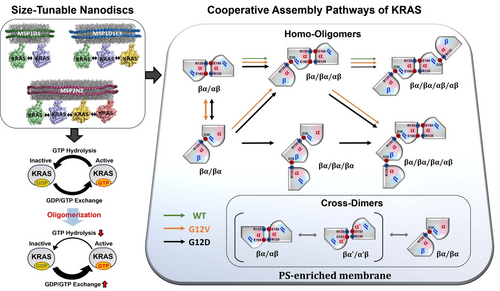Conditional Cooperativity in RAS Assembly Pathways on Nanodiscs and Altered GTPase Cycling
Graphical Abstract
Size-tunable nanodisc platforms and NMR revealed the structural mechanism for the cooperative self-assembly of both wild-type and oncogenic mutants of native, fully processed KRAS on the membrane. The cooperativity is modulated by the mutation and nucleotide states of KRAS and the lipid composition of the membrane. Higher-order oligomers retain higher numbers of active GTP-bound protomers by reducing GTP hydrolysis and increasing GDP/GTP exchange.
Abstract
Self-assemblies (i.e., nanoclusters) of the RAS GTPase on the membrane act as scaffolds that activate downstream RAF kinases and drive MAPK signaling for cell proliferation and tumorigenesis. However, the mechanistic details of nanoclustering remain largely unknown. Here, size-tunable nanodisc platforms and paramagnetic relaxation enhancement (PRE) analyses revealed the structural basis of the cooperative assembly processes of fully processed KRAS, mutated in a quarter of human cancers. The cooperativity is modulated by the mutation and nucleotide states of KRAS and the lipid composition of the membrane. Notably, the oncogenic mutants assemble in nonsequential pathways with two mutually cooperative ‘α/α’ and ‘α/β’ interfaces, while α/α dimerization of wild-type KRAS promotes the secondary α/β interaction sequentially. Mutation-based interface engineering was used to selectively trap the oligomeric intermediates of KRAS and probe their favorable interface interactions. Transiently exposed interfaces were available for the assembly. Real-time NMR demonstrated that higher-order oligomers retain higher numbers of active GTP-bound protomers in KRAS GTPase cycling. These data provide a deeper understanding of the nanocluster-enhanced signaling in response to the environment. Furthermore, our methodology is applicable to assemblies of many other membrane GTPases and lipid nanoparticle-based formulations of stable protein oligomers with enhanced cooperativity.
Conflict of interests
The authors declare no conflict of interest.
Open Research
Data Availability Statement
The data that support the findings of this study are available from the corresponding author upon reasonable request.





